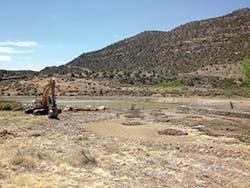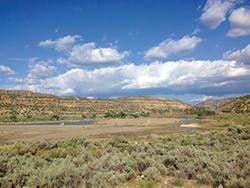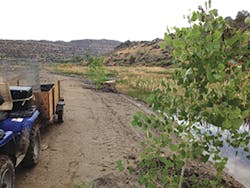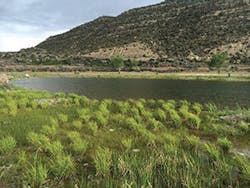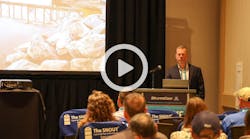Project Profile: Munoz Flats Habitat Improvement Project Future
MUNOZ FLATS WAS HISTORICALLY part of the floodplain of the San Juan River in northwestern New Mexico. A project was developed to enhance wildlife habitat, create more opportunities for fishing and hunting, and improve access to the San Juan River. Project funding was provided by the New Mexico Department of Game and Fish habitat fund.
The project area was the historic construction and crusher site for the gravel fill for Navajo Dam. The dam is the tallest earth-filled dam in North America at 402 feet. The tailwater below the dam is a trophy trout fishing water that boasts more than 300,000 fishing hours per year and brings approximately $34 million into the local economy annually. The first 4 miles below the dam are inhabited by approximately 70,000 trout. Fish over 25 inches in length are not unusual.
A peculiar and unfortunate social interaction occasionally takes place on this reach of the river as well. During the fall duck and goose hunting season, hunters set up decoys and settle into their camouflaged blinds early in the morning, often in the dark. Around sunrise, the fishermen show up to take advantage of the early light fishing. If the fishermen are new to the San Juan (they come from all over the country and some from overseas), they are unaware of the hunter’s presence—until the first shots go off as the birds come into the decoys. This disturbs the fishermen, and some have complained. One of the secondary goals of the Munoz Flats project is to provide some additional space between the two groups of sportsmen.
The first phase of the project involved removal of non-native salt cedar and Russian olive trees across approximately 50 acres. Once the site was cleared, 8 acres of ponds, 2.8 acres of new wetlands, 5.4 acres of improved existing wetlands, and several hundred yards of stream channel that connected the ponds were excavated. Water from a natural wetland area along the San Juan floodplain is diverted through a box culvert and then flows through the new ponds and wetlands via stream channels and returns to the San Juan.
Excavation and shaping of the ponds, wetlands, and channels was done by Ajacs Construction of Albuquerque and Bloomfield, NM. The project involved approximately 110,000 cubic yards of earthwork. Erosion control was modest in scale, largely because the site was nearly flat and most exposed slopes drained into the ponds. Approximately 40,000 native wetland plugs were planted in the moist soil and shallow water zones and spread rapidly across the site, providing excellent erosion control. The drier upland areas were seeded with native grasses and covered with straw mulch that was crimped with a disc. The spillways between ponds were constructed with large natural stone. The final discharge spillway is an adjustable box culvert.
The project design and construction oversight was done by Chris Philips of Riverbend Engineering, with offices in Durango, CO, and Albuquerque, NM. Project management from the New Mexico Department of Game and Fish was provided by Marc Wethington, who has managed the fishery along the San Juan for 21 years. This year he received the Lifetime Achievement Award from the American Fisheries Society (also known as the Fish Head of the Year Award) for his numerous habitat restoration projects and successful fisheries management of this remarkable trophy fishing water.
Revegetation work followed as soon as the ponds and channels were filled to normal operating levels. Thirty species of native wetland sedges, rushes, bulrushes, and grasses were planted along the shorelines of the ponds and stream channels using nursery-grown plugs from Hydra Aquatic Inc. of Albuquerque. Hydra also installed container-grown cottonwood trees, five species of willows, and six species of native shrubs in the areas adjacent to the ponds.
The desired wildlife habitat and recreational opportunities have exceeded expectations, as have the positive comments the Department of Game and Fish has received from the public. The public support inspired a second project downstream, just above the Hammond Reservoir irrigation diversion. A small diversion flowed into a channel that led to a pond and wetland area. The pond then drained by a discharge channel back to the San Juan River. Fish habitat improvements were made in the river channel itself at this site, including a large stone weir that created a pool with eddies on both sides.
The design phase has been completed for a third project upstream of the Munoz Flats area. Construction for this project is currently awaiting funding approval.
